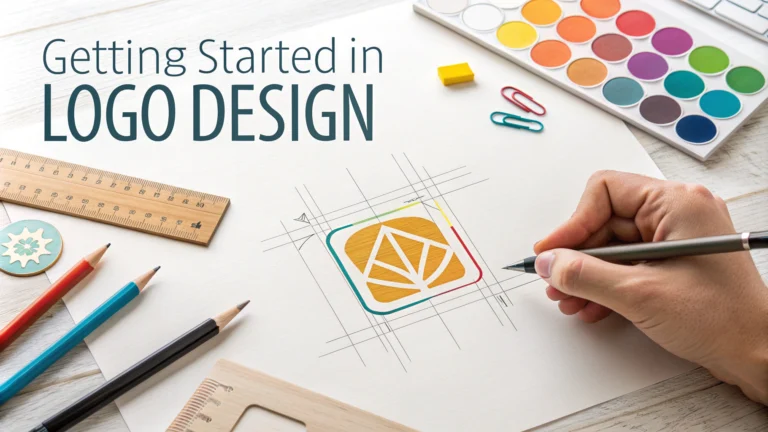Logo design combines artistry and strategic thinking to create visual identifiers that represent brands effectively.
A well-designed logo becomes the cornerstone of brand identity, appearing on everything from business cards to billboards.
Essential Tools for Logo Design
- Adobe Illustrator – Industry standard for vector graphics
- Affinity Designer – Cost-effective alternative to Illustrator
- Figma – Collaborative design tool with free tier
- Sketch – Popular among Mac users
Basic Design Principles
- Simplicity – Clean designs are more memorable
- Scalability – Logos must work at any size
- Versatility – Should look good in color and black/white
- Relevance – Must connect with target audience
Step-by-Step Design Process
- Research the client’s industry and competitors
- Sketch initial concepts by hand
- Create digital versions of strongest concepts
- Test designs across different applications
- Refine based on feedback
- Prepare final files in various formats
Common Logo Types
- Wordmarks – Text-only designs (Google, Coca-Cola)
- Symbols – Iconic marks (Apple, Nike)
- Combination marks – Text and symbols together
- Lettermarks – Initials or acronyms (IBM, HBO)
File Formats to Deliver
- AI/EPS – Original vector files
- SVG – Web-ready vector format
- PNG – With transparent background
- JPG – For general use
- PDF – For print materials
Color Considerations
Select colors that align with brand personality and psychology.
| Color | Association |
|---|---|
| Blue | Trust, Professionalism |
| Red | Energy, Passion |
| Green | Growth, Nature |
Typography Tips
- Choose fonts that match brand personality
- Limit yourself to 1-2 fonts maximum
- Ensure readability at small sizes
- Consider purchasing premium fonts for uniqueness
For professional development, join design communities like Behance or Dribbble.
Take online courses through platforms like Skillshare or LinkedIn Learning to improve your skills.
Advanced Design Techniques
- Grid Systems – Using mathematical proportions for balance
- Negative Space – Creating hidden meanings
- Custom Typography – Developing unique letterforms
- Golden Ratio – Applying natural proportions
Testing and Validation
- Test across different devices and mediums
- Gather feedback from target demographic
- Check for cultural sensitivity
- Verify trademark availability
- Create mockups in real-world contexts
Brand Guidelines
- Logo Spacing – Define clear space requirements
- Size Restrictions – Set minimum dimensions
- Color Variations – Specify approved combinations
- Usage Rules – Document do’s and don’ts
Common Mistakes to Avoid
- Following trendy designs blindly
- Overcomplicated illustrations
- Poor scalability testing
- Inappropriate font choices
- Insufficient research phase
Future-Proofing Designs
Create logos that remain effective across:
- Emerging technologies
- New marketing channels
- Various cultural contexts
- Different business expansions
Conclusion
Successful logo design requires a balance of creativity, technical skill, and strategic thinking. Focus on creating timeless designs that communicate brand values effectively while maintaining versatility across all applications. Regular practice, continuous learning, and staying updated with industry trends will help develop expertise in this dynamic field.
Remember to document your design process and maintain organized files for future reference or modifications. Building a strong portfolio of diverse logo projects will demonstrate your capabilities to potential clients.
FAQs
- What is the first step in starting a logo design career?
Learn the fundamental principles of design including color theory, typography, shapes, and composition through formal education or self-study using reputable resources. - What software do I need for logo design?
Industry-standard vector graphics software like Adobe Illustrator or Affinity Designer is essential, as logos need to be scalable without losing quality. - How much should I charge for logo design as a beginner?
Start with rates between $200-$500 for basic logo packages while building your portfolio, then gradually increase prices as you gain experience and expertise. - What should be included in a basic logo design package?
A basic package typically includes 2-3 initial concepts, 2-3 revision rounds, and final files in various formats (AI, EPS, PDF, JPG, PNG) in both color and black/white versions. - How long should the logo design process take?
A professional logo design process typically takes 2-4 weeks, including research, conceptualization, client feedback, and revisions. - What file formats should I deliver to clients?
Provide vector files (AI, EPS, SVG) for scalability, and raster files (JPG, PNG) for digital use, along with both CMYK versions for print and RGB for digital. - What makes a logo design effective?
An effective logo should be simple, memorable, versatile, appropriate for the industry, and work well in both small and large sizes while conveying the brand’s message. - How do I protect my logo designs legally?
Use contracts for client work, register copyrights for original designs, and consider trademark registration for completed client logos through proper legal channels. - What research should I do before starting a logo design?
Research the client’s industry, competitors, target audience, brand values, and current design trends while gathering inspiration from reputable design resources. - How can I create a distinctive logo design style?
Develop your unique style by practicing regularly, studying successful logos, experimenting with different techniques, and staying updated with design trends while maintaining timeless principles.








